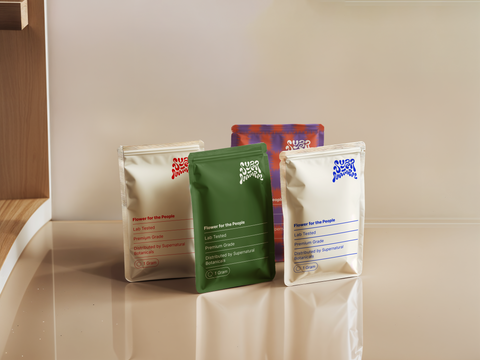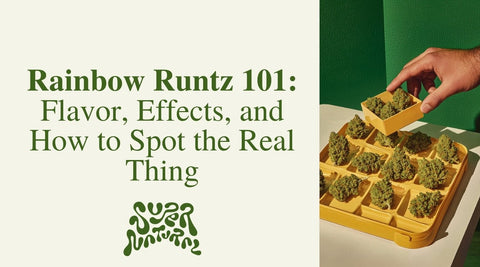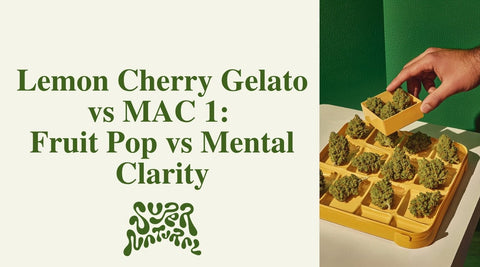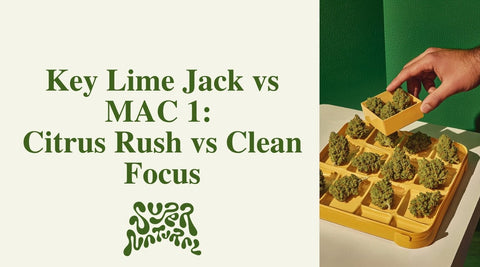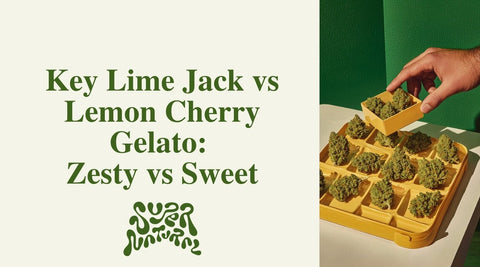
Beyond THC: The Building Blocks of a High
THC gets all the credit, but anyone who’s actually smoked quality weed knows it’s not working alone. Cannabis is a full-spectrum plant, chemically complex, rich in layers, and absolutely worth dissecting.
Every hit you take is shaped by more than just potency. That cerebral lift, body melt, mood switch, or flavor burst? That’s a symphony of phytochemicals doing their thing.
Here’s the breakdown:
-
Cannabinoids like THCa, THC, CBD, and CBN interact directly with your body’s endocannabinoid system
-
Terpenes like myrcene, limonene, and pinene steer the flavor, scent, and feel
-
Terpenoids, the oxidized versions of terpenes, develop during curing and change how the high lands
-
Flavonoids and minor alkaloids contribute color, bitterness, and subtle bioactivity
If you're buying weed just based on THC percentage, you're shopping like it’s 2009. Today’s heads are chasing aroma, effect, and consistency.
But here’s the problem. Most flower on the market is either half-cured, moldy, or stripped of terpenes by bad storage and worse shipping. That’s why we created Stay SuperNatural. Our team has spent years curating THCa flower that passes full-panel lab testing.
We don’t cut corners. Every batch is tested for pesticides, heavy metals, mold, and mycotoxins because smooth, safe smoke isn’t negotiable. And unlike a lot of brands, we blind-test for flavor and effect before it even hits our site.
Trichomes: Where All the Good Stuff Is Stored
Every cannabis plant is covered in tiny structures that look like glitter to the naked eye. But those aren’t just visual flair. They’re trichomes, and they carry the entire weight of the plant’s potency, aroma, and therapeutic value.
Without them, there’s no high, no flavor, and no entourage effect. Trichomes are where cannabinoids are synthesized and stored. They also hold the terpenes that give each strain its unique scent and impact.

The Role Trichomes Play on the Cannabis Plant
Trichomes evolved as a survival tool. They protect the plant from UV radiation, repel pests, and help the flower deal with temperature fluctuations. But their usefulness extends far beyond defense.
Trichomes are the source of THCa, CBD, and the full terpene profile. These compounds aren’t just produced in the plant as a whole. They live inside the glandular heads of trichomes, which are most abundant on mature flower.
The more trichomes present, the more cannabinoids and terpenes you’re getting, but only if they’ve been properly developed. High trichome count doesn’t guarantee quality unless the heads are intact, the stalks are firm, and the coloration reflects proper ripeness.
Spot the Three Trichome Types
There are three main trichome types you’ll find on a cannabis bud:
-
Capitate-stalked: These are the largest and most potent. You’ll see them on the outer surface of well-grown flower. They’re the source of nearly all cannabinoids and terpenes.
-
Capitate-sessile: These are smaller and typically located on sugar leaves around the flower. They contain some active compounds but not nearly as much as the stalked version.
-
Bulbous: The tiniest of the bunch. These appear all over the plant, including stems, but contribute little to nothing in terms of psychoactive content.
Knowing the difference matters. A plant dusted with tiny trichomes may look frosty but deliver a weak experience if those trichomes are mostly bulbous or underdeveloped.
Trichome Density Indicates Quality
You can learn a lot about your weed by inspecting trichomes. A magnifier helps, but even a close look with your phone’s camera can tell you what you need to know.
Clear trichomes signal that the plant was harvested too early. These won’t provide a full cannabinoid profile. Milky trichomes are ideal, packed with active THCa and rich in terpene content. Amber trichomes indicate some of the THCa has degraded into CBN, which tends to produce a more sedating effect.
If you see a nug that looks too frosty to be true, it might be.
Some brands dust mids with loose trichomes or low-quality kief to fake potency. Rest assured, Stay SuperNatural does things differently as we don’t just look for frost. We look for maturity, density, and actual cannabinoid content.
Terpenes: Hidden Drivers of Your Head Trip
Terpenes might not show up in bold print on a label, but they shape your experience just as much as cannabinoids do. These aromatic compounds are what your nose picks up when you crack open a jar of good flower.
Beyond their sensory impact, terpenes affect your body and mood in real ways. Some promote relaxation, others focus or energy. Many interact with your endocannabinoid system to boost or balance the effects of THC and CBD.
They’re the unsung heroes of the cannabis world, and learning about them is the key to moving past shopping by THC percentage alone.

What Are Terpenes Good For?
Terpenes are found all over nature, not just in weed. They’re what give lavender its calming scent, citrus its brightness, and pine needles their sharpness. In cannabis, they do even more.
These compounds not only determine how flower smells and tastes but also how it hits.
Certain terpenes can relax the body, reduce anxiety, reduce inflammation, or elevate your mood. When combined with cannabinoids like THCa or CBD, they create what's known as the entourage effect. This synergy is why two strains with the same THC percentage can produce completely different experiences.
Terps You’ll Find in Cannabis
Here are five terpene heavy-hitters that show up again and again in the best flower:
-
Myrcene: Musky and herbal. Known for its sedating, body-heavy effect. Great for end-of-day use.
-
Limonene: Bright citrus aroma. Often associated with stress relief and mood elevation.
-
Pinene: Smells like a hike through a pine forest. Can promote mental clarity and alertness.
-
Linalool: Soft, floral, and calming. Helps ease anxiety and promote relaxation.
-
Caryophyllene: Peppery and bold. Uniquely interacts with the CB2 receptor to offer anti-inflammatory support.
Knowing your terpene preferences is more reliable than strain names when it comes to predicting effects. Especially now that naming conventions are more marketing than science.
Terp Profiles Vary, as Do Their Effects
Even within the same strain, terpene levels can vary based on harvest time, storage, and how the plant was grown. That’s why your favorite flower might hit differently from one batch to the next.
When terpenes team up with cannabinoids, the result is more nuanced, more effective, and more enjoyable. That’s the entourage effect in action. It’s not just theory. You’ll feel the difference.
Terp-Star Strains at SuperNatural
If you want to taste the spectrum, start with these two terp-heavy strains from our collection:
Rancid Rainbow
Loud citrus with a spicy undertone. Known for lifting moods and leveling out stress.
Red Velvet
Rich berry and cream aroma. Mellow but not sleepy, perfect for decompressing without zoning out.

Terpenoids: Secondary Agents with a Key Mission
Terpenes may take the spotlight, but once cannabis goes through curing and drying, something new develops. These changes give rise to terpenoids. They’re formed when oxygen interacts with original terpene structures, subtly altering their chemistry.
What you’re left with are compounds that shift how cannabis smells and feels, adding layers that aren’t present in freshly harvested flower.
You’ve likely experienced the difference without realizing it. That slight edge in aroma, the way a strain lingers on your tongue or hits your body differently even when THC and terpenes seem identical on paper, those effects often point to terpenoids.
Terpenes vs Terpenoids—What’s the Difference?
Terpenes are raw plant compounds. They exist in the living cannabis flower before it's ever trimmed or cured. Think of them as fresh, volatile oils that give off the plant’s immediate scent and flavor.
Terpenoids show up after drying or curing. Exposure to oxygen and time triggers a natural transformation, slightly adjusting the structure of some terpenes.
These modified versions often create deeper, richer aromas or shift the therapeutic feel of the flower. That’s part of why well-cured bud tends to have a smoother, more layered effect than raw or flash-frozen alternatives.
Common Terpenoids in Cannabis
Here are a few terpenoids that show up regularly in cured, well-grown cannabis:
-
Linalool oxide: A gentler version of linalool with soft floral tones. Often present in strains known for calm, steady effects.
-
Menthol derivatives: These bring a cool, minty edge that can freshen both flavor and sensation.
-
Camphor-type compounds: Add a sharp, herbal note and a slight physical lift that rounds out the overall profile.
What You Get from All Those Phytochemicals?
Cannabis is not a single-note experience. Every hit involves dozens of active compounds working together. Trichomes produce and store these compounds, while terpenes and terpenoids direct the feel, flavor, and finish.
The deeper you understand what these phytochemicals do, the easier it becomes to choose strains that match your vibe, your needs, and your expectations.
Aroma = First Impact
Your nose knows. The moment you open a jar, the smell tells you everything. Loud, vibrant aromas usually mean terpene-rich flower. Whether it hits you with lemon, pine, fuel, spice, or something sweet, those notes are real signals of quality.
On the other hand, when flower smells flat or faint, it is often a sign that terpenes have degraded or were never there in the first place. Properly cured and well-preserved weed should always announce itself.
Flavor = Next Level
Flavor is the product of terpenes merging with intact trichomes to create something that is actually enjoyable to smoke. This is where good cannabis distinguishes itself.
A layered taste that evolves from inhale to exhale is what separates top-shelf from filler. When trichomes are broken or burned off and terpenes are stripped in the process, what is left behind often tastes harsh or grassy.
With full-flavored flower, you get depth, not just scent.
Effects = The Under the Hood Chemistry
The high you feel is more than just THC. Terpenes guide how that THC behaves in your system. Some speed things up. Others mellow things out. The presence of linalool or myrcene can shift your mood toward calm, while limonene and pinene can sharpen your focus or elevate energy.
Even when two strains share the same THCa content, the one with a stronger terpene presence will almost always deliver a more nuanced, body-aware experience. Cold hits from terpene-heavy flower feel smoother and more intentional.
You are not just getting high. You are engaging with a plant that was grown, harvested, and handled with care.
How to Tell When the Trichomes Are Actually Fire
Frosty buds get attention, but smart buyers know it is the condition of the trichomes that tells the real story. This is where the cannabinoids and terpenes live. When they are mature and intact, they deliver everything from aroma to effect.
If they are broken, dried out, or harvested too early, you lose more than potency. You lose the full experience.
Look for Milky Frost, Stickiness and Scent
Trichomes go through a visible lifecycle. Clear trichomes are not fully developed. Milky trichomes are ideal for most flower, holding the highest concentration of THCa and preserving terpene content.
A touch of amber can signal a smoother or more relaxing effect. The best flower usually has a blend of both.
Stickiness is a physical clue that those trichomes are still alive and holding resin. A good nug should resist the grind just a bit. That is a sign of oil-rich heads, not dry leftovers.
It should smell vibrant, not flat or grassy. If it smells like citrus, spice, fuel, or fruit and sticks to your fingers, that flower is carrying real content.
Buyer Blind Spots to Dodge
Some brands go heavy on visual frost and light on everything else. There are still products being sold that have been sprayed with kief or puffed up with appearance tricks. That might look impressive in a photo, but it falls apart in a jar.
Storage also plays a role. Flower that has been sitting in direct light or kept in cheap plastic containers loses terpene content quickly. Once those volatile oils evaporate, you are left with dry trichomes and dull effects.
Always store your bud in airtight glass away from heat to keep those trichomes and terpenes intact.
Strains Dripping in Trichomes at SuperNatural
Two of our most resin-packed picks right now are standouts for any trichome chaser:
Drip Station has thick, milky coverage and hits with a blend of citrus and spice.

Caked Up Cherries is dense, rich, and leaves your fingers coated. The high is steady, relaxed, and very reliable.

Solve the Flavor Puzzle and Enjoy the Ride
Cannabis is not defined by one compound. Trichomes, terpenes, and terpenoids shape how flower smells, tastes, and feels in your body. When grown right and handled with care, they deliver clarity, relaxation, elevation, or full-spectrum body buzz without compromise.
Stay SuperNatural is serious about THCa flower. Every jar is hand-selected and quality-verified. If you want flower that speaks for itself the moment you open the lid, you will find it here.
Explore our current lineup of THCa flower at the Stay SuperNatural website and discover flavors that you never dreamed existed!

